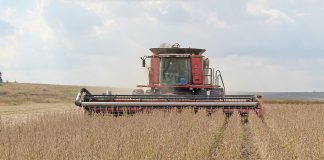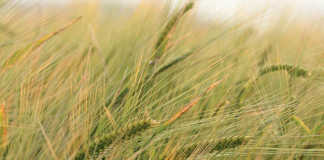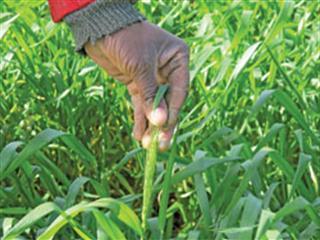
Photo: Keri Harvey
For 42 years, Pierre Heydenrych has been engaged in wheat farming on the West Coast in the Vredenberg area. During this time he has added three neighbouring farms to the land he inherited. Today, he farms on 5 000ha, of which 800ha is under wheat. The remaining land is used to run 2 000 Mutton Merino sheep and 400 Angus beef cattle. Until last year he milked 600 cows, but he sold his dairy herd because it was no longer viable.
SEE ALSO: Promising start to the wheat season
Pierre’s farm Uitkoms is considerably larger than the district’s average-sized farm of about 1 200ha. He also has the largest area under wheat. He attributes his success to “hard work and having nature on your side”. “In the early days when I started wheat farming, the annual rainfall was higher than it is now and the wheat price was better. Producing wheat is more difficult now. We have better and more sophisticated equipment, but there is nothing we can do about the rainfall.”
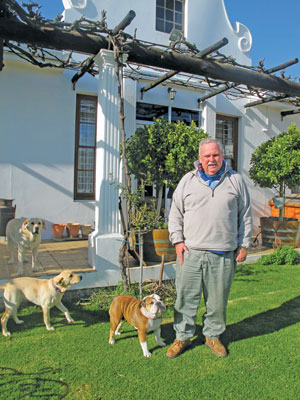
Pierre is a fourth generation farmer on Uitkoms in the Koppiesveld just outside Vredenburg.
Factors affecting wheat farming
-
Growing conditions
The soil is not the main issue in wheat farming, says Pierre – it’s rain that is most important. “Rain is critical to whatever you farm; soil can be fertilised but you can’t do anything without water. For a good crop of wheat we need 200mm of rain to fall between mid-April and the end of September. If it is evenly distributed, we can have a really good harvest. Less rain is still manageable, but then it must be well spread out over the months.”
-
Cultivars
Pierre says the wheat cultivars planted have changed since he took over farming from his father in 1970. The National Chamber of Milling advises farmers and buyers as to which cultivars are the most suitable for their specific area. “Here, on the West Coast there is one wheat crop a year. I plant SST 88 and SST 027 cultivars. SST88 is a slower grower but is more drought-resistant, while SST 027 is a faster grower and more suited to sandy soil.
I have different soil types here, so I plant the cultivar most suited to the specific area of the farm. We plant more SST 88 than SST 027.” In certain areas of South Africa, GM wheat is already planted, says Pierre, but not on the West Coast. “If I had the option, I would plant GM wheat. It is drought resistant, has a higher yield and has been proven in the US to be safe for human consumption.”
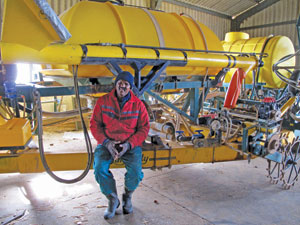
Planting and fertilising is done in a single process, using specialised equipment. Seen here is Deon Damon, manager at Uitkoms.
-
Production process
“Planting starts in the last week of April and harvesting between 10 October and 15 October. We plant whether it has rained or not. This year we had poor rain in May, which delayed germination. Growth will be stunted and the whole production process slowed down. “We will still harvest in October, but not as much as usual. I expect a yield of about 2,5t/ha this year. After harvest the wheat is transported to storage in the grain silos in Vredenburg.”
Pierre says there is a new practice in wheat farming, where harvested wheat is bagged and sold to independent buyers at prices negotiated between buyer and farmer. “I am thinking of doing it this year as it cuts out the transportation cost. Buyers come to collect wheat from the farm and farmers negotiate directly with buyers.”
-
Pest control
There are not as many pest problems as there were 20 years ago, Pierre says. “I spray the crop with a herbicide. I can’t just plough and plant and expect to harvest at the end of September. Mistakes made in the production process, cost money.”
In the Vredenburg area witroes (powdery mildew) and weeds are the primary problems in a wheat crop.
“Yellowed wheat around land edges is a sign of herbicide use on the boundaries. However, general yellowing of wheat is usually a sign of nitrogen deficiency in the soil, which stunts wheat growth. He explains that the West Coast’s winter fog is not a problem for wheat. “If it rains while we are harvesting in October we can have a rot problem in the wheat. And there’s nothing we can do about it.”
Expected yields
The Swartland wheat yield averages about 4t/ha while the Sandveld yields about 1,6t/ ha. Here, in the clay-lime soil near Vredenburg, Pierre’s yield is between 1,8t/ha and 2,5t/ha depending on the annual rainfall and its distribution. The Koppiesveld soil around Vredenburg is similar to that of the Swartland, but there is less rain.
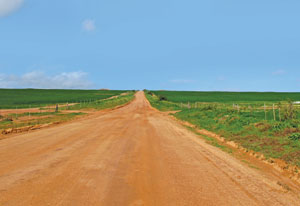
Pierre’s wheatlands roll on for 800ha, making him the biggest wheat farmer in the Vredenberg district. His 5 000ha farm stretches from Vredenburg to Paternoster on the West Coast.
Challenges
“Farming wheat in 2012 is far more challenging than when I started,” says Pierre. “At the moment the wheat price is rising, but price is always a problem for wheat farmers. There are no quotas in the wheat industry, but low prices hold us back. Currently the wheat price is around R3 400/t.” South Africa has the capacity to produce enough wheat and eliminate imports, but the low wheat price discourages planting, he says. “Many wheat farmers in the Vredenburg area no longer produce wheat because of low prices.”
The future
Pierre believes government intervention may be necessary for an increased wheat price to South African wheat farmers.
“I don’t want a subsidy, just a good price for my product. We have to compete with subsidised countries so we need government protection from that.” He says South Africa exports no wheat but imports 1,5 million tons a year.
“I won’t increase the area under wheat, until prices improve. With a rise in the wheat price we could replace old farm machinery and pay our labourers more so they could have a better life.” Pierre employs 14 permanent staff members, who live on the farm.“If I do things right and the rains come, then all will be well,” he says with a smile.
For more information visit www.grainsa.co.za











